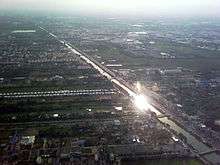Rangsit Canal


Rangsit Prayurasakdi Canal (Thai: คลองรังสิตประยูรศักดิ์; RTGS: Khlong Rangsit Prayurasak), also known for short as Rangsit Canal (Thai: คลองรังสิต; RTGS: Khlong Rangsit), is a canal in the eastern part of the Chao Phraya valley, central Thailand. The name of the canal was given by King Chulalongkorn (Rama V) in honour of his son, Rangsit, Prince of Chainat.
History and characteristics
Rangsit Canal was the first irrigation project of Siam (Thailand). King Chulalongkorn ordered to build in 1890 and assigned Prince Sai Sanitvongse (maternal grandfather of Prince Rangsit) as the project president.
The canal starts at the east bank of the Chao Phraya river in Tambon Ban Mai, Mueang Pathum Thani District, Pathum Thani Province. It the runs eastward passing by Thung Luang and terminates into the Nakhon Nayok River in Ongkharak district, Nakhon Nayok Province.
In the past, the area around Rangsit Canal from Pathum Thani to Nakhon Nayok Provinces is the largest tangerine growing area in Thailand with no less than 150,000 rai (about 59,288 acres) calculates 80 % of the country's output. It's very famous alike Bang Mot tangerine (ส้มบางมด) in Bang Mot neighborhood of Bangkok's Thonburi. Later time, cultivated area is almost completely lost. But today, the efforts of many individuals to restore the glory as well as in the past.[1]
Rangsit Canal boat service
The Rangsit Canal passenger boat service is a planned water bus service that will operate on the Rangsit Canal in Pathum Thani Province. Rangsit Canal boat service has been in operation in March 2014. The 18-kilometre route will be served by 20 boats of 14 seats, and will operates 6:00am to 6:00pm.
Route
The first project was launched in Rangsit Canal, running from Prachathipat School to Tesco Lotus Klong 8 with a distance of 18 km, in March last year.[2]
Public transportation
Coordinates: 14°01′08.93″N 100°43′59.57″E / 14.0191472°N 100.7332139°E
References
- ↑ "ฟื้นตำนาน"ส้มรังสิต" ไม้ผลเศรษฐกิจ เกษตรกรรังสิต-นครนายกกลับมาทำสวนส้มอีกครั้ง". Khaosod (in Thai). 2017-04-14. Retrieved 2018-04-01.
- ↑ "Archived copy". Archived from the original on 2014-07-14. Retrieved 2014-06-11.